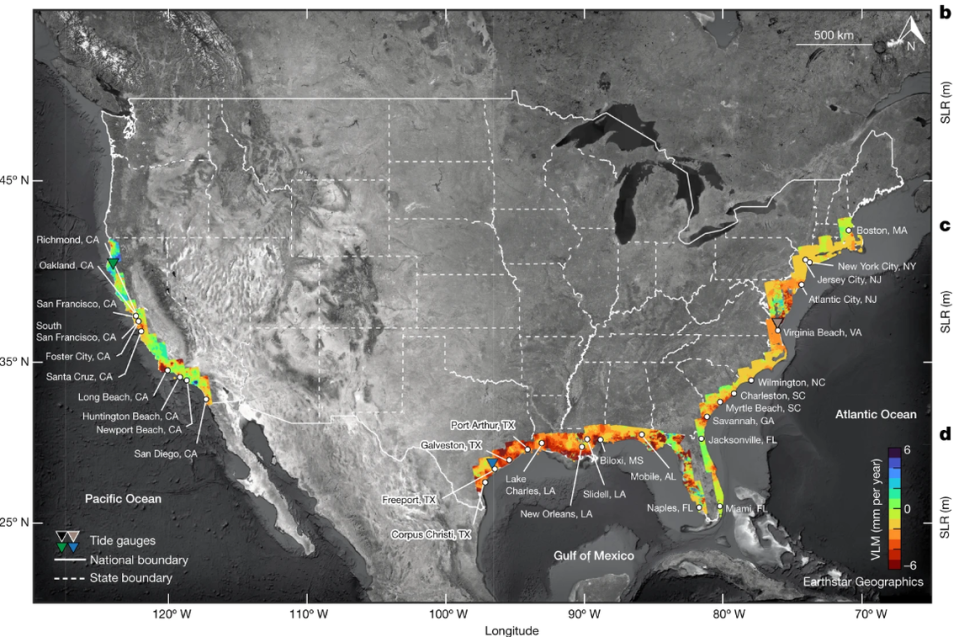Sea levels are rising, but is South Florida also sinking? What the research shows
In South Florida, sea levels have already risen several inches since the start of the century and could be around six feet higher by 2100. But another factor could be making those sunny day floods in South Florida worse: We’re sinking.
Well, only a little bit. And only in some places. That’s according to new and old research on the phenomena of sinking land — also known as subsidence — along the entire U.S. coast.
Earlier this month, new research published in the journal Nature showed the potential risk of a one-two combo of sinking land and rising seas to cities along the coast, and Miami topped the list as a location that could see quite a bit of flooded property by mid-century.
The paper, led by researchers at Virginia Tech, suggested that Miami could have around 80,000 properties flooding by mid-century, a multibillion-dollar risk, due to the combination of sinking land and rising seas.
Associate Professor Manoochehr Shirzaei at Virginia Tech’s Earth Observation and Innovation Lab, co-author of the study, said he believes cities aren’t taking the slipping elevation of their coastal land as seriously as they take sea level rise.
“The coastal hazard through 2050 is more likely driven by land subsidence than sea level rise, and this has to come across very clearly in every sea rise strategy,” he said. “I’m confident in this moment in most places, this is not the case.”

Subsidence is caused by several things, from glaciers moving or melting in the North Pole to overpumping oil, gas and groundwater, or, in South Florida’s case, compacting soil.
While the nationwide maps make clear that the real problem area for subsidence is in the Gulf Coast, specifically in places like Louisiana, Shirzaei said South Florida should still be paying attention to the future risk.
Specifically, he said, on the glitzy, expensive island communities that ring the coast of the Sunshine State.
“You do have some of the famous barrier islands. All of them are sinking,” he said.
How South Florida stacks up
Local research into subsidence in South Florida has found that yes, indeed, there are spots along the coast that are lower than they were decades ago. That’s especially true on barrier islands, said Shimon Wdowinski, a geophysics professor at Florida International University who has published several papers on subsidence.
But it’s only a minuscule amount.
His 2020 paper compared Miami Beach to Norfolk, Virginia, and found that Miami Beach experienced very little subsidence overall. It also happens in small patches, typically around new construction. In that paper, he noted that the Champlain Towers condominium building in Surfside sank at a rank of 2 millimeters a year from 1993 to 1997 — about the width of two credit cards stacked on top of each other.
His research, released before the tragic 2021 collapse, initially led some to believe that sinking earth could have played a role in the disaster, but the investigation has so far not pointed to land change as a culprit.
Wdowinski said that his research suggests that land subsidence is mostly localized to the space of a single building in South Florida, and it’s by design. Heavy buildings compact the soil, so good engineers design buildings with the knowledge that they will slowly settle over a long period of time.
And that’s not just because of South Florida’s dirt. It can be what’s underneath, too. When barrier islands like Miami Beach were first built or expanded, it was common practice to mow down trees and mangroves and use those cuttings to expand the island. Decades later, those trees have rotted, sinking the earth down a bit.
“In southeast Florida, we have mostly localized subsidence, which is associated with construction of new buildings,” Wdowinski said. “The weight of the building is actually pushing down, and if you have the proper foundation it should be fine.”
The problem comes when one side of the building sinks faster or further than another side, potentially straining the building’s foundation or the pipes underneath.
That is, unless the seas are rising.
South Florida is already a low-lying place, so millimeters matter here. Continued subsidence, paired with rising seas, rising groundwater levels and more intense rainstorms could leave South Florida at risk of more frequent and more intense floods.
That’s why Wdowinski is pursuing more grants and more research into the phenomenon all across the state. While he’s confident that sinking is a bigger problem on the Gulf Coast — including Florida’s west coast — he noted that all information is important when it comes to planning for climate change.
“It’s a factor. It’s not the most important one. But still, if we can get a better grip on that it would be helpful,” he said.

